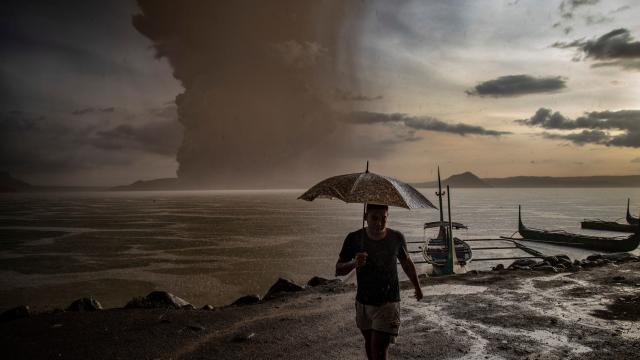An eruption at the Philippines’ Taal volcano sent locals fleeing for cover as towering ash clouds rose on Monday. Lightning licked the plumes of smoke rising from one of the most active volcanoes in an island nation with dozens of others in various states of unrest.
The local effects of Taal are clearly devastating, as ash rains down on nearby communities. But the volcano also spewed sunlight-blocking particles that theoretically could cool the planet. Unfortunately for us, it’s not going to be enough.
To be clear, Taal is a serious emergency for the communities in its shadow. That includes Manila, which is just about 65km to the north. There’s still a 15km evacuation zone, and the Philippines Institute of Volcanology and Seismology has the alert level at four, one step below the most dire alert. Lava fountains and ash continue to ripple out of the volcano, which sits in the middle of a lake (which itself is inside the caldera of a much bigger volcano, because Earth is just intense like that). The risk of a more dramatic eruption remains, though it may be subsiding a bit. But the point is, the eruption is a majorly bad deal for the Philippines.
And turns out, it’s not going to give us a reprieve from climate change either. When volcanoes erupt, they can send a whole host of chemicals into the sky. One of those is sulphur dioxide, also known as volcanic smog or vog. When it’s close to the ground, it’s a huge public health concern and causes respiratory issues. If it reaches the atmosphere, it can mix with clouds and water droplets to form acid rain.
But if vog shoots even higher and reaches the stratosphere, it can have cooling effect on the planet by reflecting sunlight back into space. We saw that during the 1991 Pinatubo eruption, which sent 16-18 gigatons of sulphur dioxide into the stratosphere. That was enough to cool the planet about 0.5 degrees Celsius for a couple years. In 1816, an eruption at Mount Tambora in Indonesia led to cooler global temperatures and widespread crop failures in Europe and elsewhere, in what was dubbed the Year Without a Summer.
So cooling can definitely go awry, but our planet is also way hotter now than it was during either of those eruptions. Last year was the second-hottest year on record, and the 2010s were the hottest decade on record. So yeah, we’re in a place where the world could have a little volcano-induced cooling as a treat while we get our shit together reducing emissions. Unfortunately, Taal will not be that reprieve.
“There are volcanos in the Philippines that have ejected enormous amounts of sulphur dioxide into the stratosphere in the past, but we’re in a totally different regime here,” Allegra LeGrande, a NASA Goddard Institute for Space Studies researcher who studies volcanoes’ impact on the climate, told Gizmodo.
Taal hasn’t emitted nearly enough sulphur dioxide or sent it consistently high enough to make an impact on the global average temperature. Erik Klemetti, a volcanologist at Denison University, told Gizmodo that the initial eruption was explosive but “much less” so than it could’ve been. I know this may seem odd, given that you could see the eruption from freaking space, but that should give you a sense of how big an eruption is needed to get sulphur dioxide into the stratosphere. What the relatively small eruption did do is essentially clear out the pipes connecting the volcano to magma chamber below, lowering the odds of a more explosive eruption down the road.
It’s not just that there hasn’t been enough pop to get sulphur dioxide into the stratosphere. Taal also hasn’t emitted much sulphur dioxide. LeGrande said you’d need roughly about a quarter of the amount of sulphur dioxide of the Pinatubo eruption to start to see a climate impact, and we’re just not at that point with Taal. Klemetti said the “odds are strongly against” the volcano getting there with this eruptive cycle. He noted that volcanoes that have emitted enough sulphur dioxide to cool the climate have often erupted unexpectedly.
So if Taal’s not going to be it, other recent eruptions haven’t been it, and we don’t know which volcanoes are likely to lend a temporary helping hand to cool Earth, we should probably just, you know, start cutting carbon pollution ASAP. Ideally, we shouldn’t have to rely on deadly natural disasters to clean up our dirty work.
